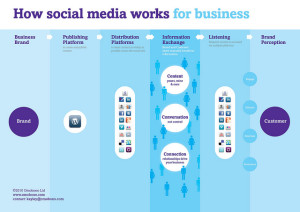How Social Media Streamlines Customer Service
Posted on February 8, 2016, at 4:11 p.m.
by Mackenzie Lyng.
Have you ever used social media as a way to get customer service? Companies are now serving consumers on the social level. As many organizations would agree, customer satisfaction is the core of building strong, lasting relationships.
Bryan Lyng, CEO and founder of Lyng & Associates, explained that a brand experience starts with excellent service. “A company’s brand experience must extend to every single touch they have with their customers” Lyng said. “This is especially true of customer service. Companies have the opportunity to emotionally connect with consumers through honest conversation and support”
 Why customer service matters on social media
Why customer service matters on social media
First, the bad news. Even if organizations think they’re doing an impeccable social customer service, chances are they are not. Research from HelpScout (link 2) uncovered that 80 percent believe they deliver superior customer service, but only eight percent of consumers think these same companies provide this level of service.
Simply put: Customers demand, expect and are ready to reward quality social customer service. But most companies fall short of their expectations.
On the other hand, there is a perfect opportunity for other brands to stand out and really wow a customer. According to Help Scout, only 36 percent of consumers who make customer service requests via social media report having their enquiries solved quickly and effectively. When brands engage with customers and answer their service requests over social media, those customers end up spending 20 percent to 40 percent more on company products. Seventy-one percent of those who experience efficient social care are more likely to suggest that brand to others consumers. And 86 percent of social media customers would like to hear from a company regarding a complaint.
Lyng said brand success derives from active social engagement. “Brands who want to succeed must master social media channels like Twitter, Pinterest or Instagram, particularly if they are targeting millennials,” Lyng explained. “Brands who can digitally evolve will be able to communicate with their audiences in a new and personalized manner.”
Pretty intriguing, right?
Even more compelling is how social media customers diverge from other consumers in terms of expectations. In many cases, social media offers greater benefits for wowing online customers. However, it also puts companies at risk for failing to provide quality service.

What social media customers want
Customer support is the very rare opportunity to connect to your customers on an emotional level. It is important to understand what digital consumers expect on social media.
1. A fast response to their problems
According to an Edison study, 42 percent of social consumers require feedback within one hour, and 32 percent expect a response within 30 minutes. But cue the irony: More consumers would endorse a brand that provides prompt but incompetent feedback than a brand that administers a slow but useful solution. In other words, it’s more important to digital customers to be timely than accurate. Dr. Regina Lewis, an advertising professor at The University of Alabama, stresses the importance of a consumer’s experience over any factor. “From typos to answer incompetency, delivery of customer service triumphs everything,” Lewis says. “Timely, respectful feedback is what people remember — it speaks to the brand experience.”
2. Care and honesty
Statistically, 70 percent of the buying experience is based on how a person thinks they’re being treated. Therefore honest care is just as important as timelines. In the vast sea of social media, it’s easy for consumers to feel unimportant. But for social care companies, customers must be reassured that they matter. Lyng discussed how brands that are socially dormant can tarnish the overall brand image. “Organizations run the risk of appearing old, inflexible, uncaring or unwilling to embrace new technology,” Lyng said. “Needless to say, none of these characteristics are desirable to brands.”
Social customer service creates a unique opportunity for organizations to turn a unsatisfied customers into a social media advocates. Simple expressions such as “I hear you” or “I apologize” can easily turn a conversation into the beginnings of a real relationship. Admit mistakes to humanize a brand’s service. If a customer is required to wait for an answer, staying in contact reassures them that their problem is important.
3. Provide help where customers ask
Generally, people want help in the same place where they asked. If a customer requests assistance on Twitter, they most like want an answer in the tweet-form rather than an email response. If they ask a question on Facebook, they don’t want to be told to call an 800 number. Recently, Twitter passed Facebook as the preferred platform to seek customer service. Twitter receives more social care demand, but brands are more often on Facebook. Aside from the most popular social sites, customers may seek help in other places, such a company blog. Either way, brands must study the behavior of each consumer network and plan accordingly.
The bottom line is most companies view social media as a marketing instrument to reach consumers on the digital space. But today’s customers expect more — and reward brands that go above and beyond.
Social media as a customer service channel allows brands to participate in online conversations with consumers and presents an additional way to build brand loyalty.
Editor’s note: Article source Bryan Lyng and author Mackenzie Lyng share a passion for brand storytelling and are in fact related — as father and daughter.




